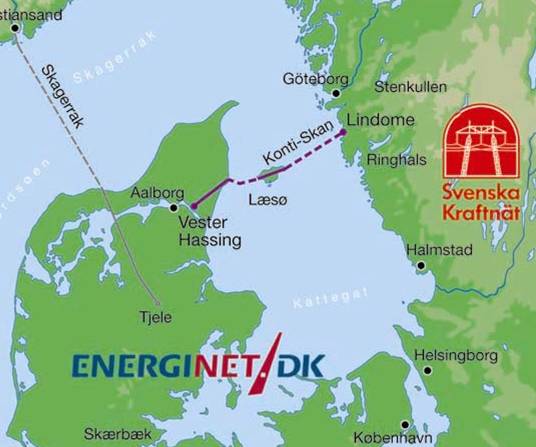initial pole 1 was opened in 1965. The technology, High-Voltage Direct Current (HVDC), was rather new and so far untested in the
chosen size. The interconnection has played a very important part in the comprehensive energy exchange between the
Nordic countries.
After 40 years in service, facilities at the substation are now technically outdated, but the system appears in the autumn of 2005 in a technically redesigned/renewed and somewhat larger version (380 MW compared to 270 MW so far) after a few years of work.
Pole 2 from 1988 added further 360 MW to the capacity of the interconnector.
|
|
The new Konti-Skan 1 (KS1) project makes it possible to control KS1 and Konti-Skan 2 (KS2) in bipole mode (KS12) from
Vester Hassing Tjele and Skærbæk in Denmark, and from Lindome and Råcksta in Sweden (Svenska Kraftnät SvK). As a part of the refurbishment of the Danish-Swedish HVDC Interconnection Converter Stations a closed LAN to Areva SCADA system will be established in the Energinet.dk local control centres at Tjele and Vester Hassing. From the centres it will be possible to control and register all events and alarms from KS1, KS2 and KS12, and subsequently is it possible to control the power via different regulation forms. The SCADA system generates a limited number of group alarms to the central control centres in Skærbæk and Råcksta. |
You can find more detailed information about the Konti-Skan project on the Energinet.dk web site at www.energinet.dk. |
|
Newcon Data AB was in 2004 selected by Energinet.dk to deliver a protocol converter that converts approximate 1000 digital
and 80 analogue signals sent from the old ABB Central Alarm System (CAS) for KS2 in Vester Hassing to a new SCADA system delivered from Areva using IEC protocol 60870-5-101. The Central Alarm System (CAS), delivered by ABB Transmission HVDC (ABB Power Systems AB) in 1987, consists of a double CPU real-time system programmed in PLM86. One CPU board (CAS1) handles the communication, via two PD-buses, with the Local Alarm System (LAS) in each cubicle and the alarm/event database. The other CPU board (CAS2) handles the communication with a TESSELATOR 8000 display system (TES). In the existing alarm system for KS2, the following data are transferred between the CAS and TES:
|

|
|
System configuration |

|
|
The TessEm system together with the Areva SCADA system in the Energinet.dk control room |
|
The delivery from Newcon Data AB consists of the following parts:
This special version of TessEm7000 contains asynchronous communication with external SCADA system through a slave implementation of the IEC 60870-5-101 protocol. It also contains a database with all the dynamic points in the CAS and a special process display showing all the analogue points in the CAS system. New commands have also been added to the TESSELATOR display protocol for more effective transfer of analogue and alarm/event information between the CAS system and the TessEm7000. Changes in the CAS system are sent from the CAS2 to the data base in TessEm7000 and further to the SCADA system as "state of change" message according to the IEC 60870-5-101 protocol. Besides transferring of data from ABB alarm system (ADLP-10 protocol) to Areva SCADA system (IEC 60870-5-101) the TessEm PC has also retained the possibility to generate all alarm, event and graphical lists and flow diagram screens on a stand-alone PC. Triangle MicroWorks, Inc. was selected as supplier of the source code for the IEC 60870-5-101 protocol. More detailed information about the IEC 60870-5-101 protocol can be find on the IEC web site at www.iec.ch.
|
